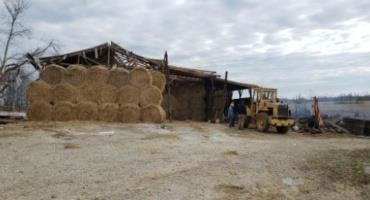“It’s very important to make every effort to secure animals in areas where fences may have been impacted,” she said. “Cattle getting out into roadways can cause a secondary emergency.”
Securing cattle may include moving them to a location where perimeter fencing has minimal damage; combining multiple groups of cattle into one area where fencing is in place; installing temporary fencing and making repairs to damaged fencing.
If the electricity is out, solar-powered fence chargers may come in handy when installing temporary fencing.
“Evaluate your feed and water resources in storm-damaged areas,” VanValin said. “You may have to haul water to cattle. People in agricultural communities are usually quick to jump in and help, so evaluating your needs will make it easier for others to assist you. At UKREC, we lost water, and we had to have it trucked in for several days. Thankfully, local farmers and the fire department were happy to help us in that effort.”
It’s a good idea to have an updated list of animal numbers and pasture locations to help account for missing livestock.
“Having an individual animal identification system and an accurate list of tag numbers will give you a way to check off cattle as you identify them,” VanValin added.

Producers moved hay out of a damaged barn in Breman, Kentucky. Photo by Katie Pratt, UK Agricultural Communications Specialist
Unfortunately, some cattle likely will suffer injuries during violent storms, including lacerations and broken bones. Working with a local veterinarian to evaluate injuries is important for developing treatment protocols. If cattle handling facilities and barns sustain storm damage, it limits producers’ ability to work and treat cattle.
“Our goal here is to do no harm,” VanValin said. “There may be injuries that could be treated in normal situations but require humane euthanasia in disasters. Some cattle may die from their injuries. While we always hope the number is low, the herd mentality of cattle may mean large numbers of cattle are in danger during natural disasters.”
Keep an accurate number of cattle lost during the severe weather event. The U.S. Department of Agriculture’s livestock indemnity program will help financially compensate producers who lose livestock. Local extension offices, USDA-Farm Service Agency offices and emergency management offices may know of other helpful programs.
Another dangerous situation is cattle consuming debris in pastures. They may ingest metal debris such as screws, nails and metal wire. The debris may become lodged and puncture the animal’s stomach, diaphragm or even the pericardium around the heart. This condition is called hardware disease, and it may be challenging to diagnose because symptoms of depression, poor appetite and reluctance to move can often mimic other conditions.
“You can place a magnet in the first compartment of the ruminant’s stomach, called the reticulum, to attract metal debris away from the stomach walls,” VanValin said. “Make every effort to prevent cattle from ingesting metal objects in affected pastures.”
Debris in pastures can also lead to additional injuries such as puncture wounds and lacerations when cattle are grazing or traveling across pastures.
“The University of Kentucky Research and Education Center in Princeton suffered catastrophic damages from an EF-4 tornado Dec. 10,” said VanValin, who is stationed at the UKREC. “Unfortunately, we lost some cattle in the UKREC beef herd in the storm and in the days that followed. However, when standing in the rubble of our buildings or in our debris-ridden pastures, I often find myself thinking that it is truly a miracle our people and our cattle were not more severely impacted by the storm.”
Another thing to watch for is reproductive complications. VanValin said stress has a negative impact on reproductive outcomes.
“The severe weather event in December undoubtedly caused stress on livestock,” she said. “Although we would typically expect tornadic activity to impact the breeding season for spring-calving herds, this outbreak occurred during fall-calving herds breeding season. At the UKREC, we use artificial insemination, and we had bred the entire herd the morning of Dec. 10. We expect conception rates for these animals to be extremely low, especially in the animals most affected by the storm. Cattle may abort due to stress. Pregnancy is a luxury; it’s not necessary for survival.”
VanValin explained that cattle have biological processes that kick in to help them survive. The processes affect every part of the body, so pregnancy and lactation may suffer negative effects of stress.
“Keep a close eye on any nursing calves in the days and weeks following a storm,” she said. “Especially watch those calves whose mother may have been injured or killed due to the severe weather.”
Reproductive complications may not show up right away, but they can create devastating impacts to a herd’s future. Producers may work with local county extension agents and veterinarians to help assess potential reproductive impacts on their herds.
“The impact of these tornadoes will be felt for many years. Those affected should continue to seek assistance as the recovery process is long and challenging. These storms were so powerful and brought so much destruction in just a matter of seconds. Still, the strength, resilience, kindness and generosity of friends, neighbors, colleagues and complete strangers from all over the United States has been stronger. The debris will be cleaned up in time, and we will rebuild the physical structures of the UKREC. In the meantime, the faculty and staff of the UKREC will continue serving the agricultural community of Kentucky and beyond.”
Source : uky.edu